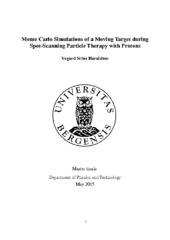| dc.description.abstract | During radiation therapy for cancer, the dose distribution delivered to patients will be affected by the motion of the target volume and the motion of the surrounding tissue and organs. The overall objective of this thesis has been to investigate how the motion of the target volume affects the distribution delivered during spot-scanning particle therapy. This has been investigated with Monte Carlo simulations of a target volume moving step vise between beam spots delivered to the target volume with a proton beam. The Monte Carlo simulations were conducted with the Geant4 Toolkit, version 10.0 patch-02, and with the QGSP_BERT_HP physics list. A detector target volume measuring 20x20x4 mm was placed within a 30x30x30 cm water phantom and moved in accordance to a simple breathing cycle and average motions between irradiation of the beam spots. 25 beam spots from a circular proton beam of radius 2 mm and energy 145,60 MeV, gauss distributed with a 0,1456 MeV standard deviation, was delivered to the target. In total the beam delivered 25*10^7 protons to the phantom. In addition to the effect of simple motion on the dose distribution, the effect of repainting within spill, delivering the dose during a gating window and re-scanning the target, was investigated. The results of the simulations indicate that movement in the beam direction and in the secondary scanning direction, had the most detrimental effect on the dose distribution. The repainting simulations indicate that repainting within a spill average out the effect of the target and beam moving simultaneously, so called interplay effects, letting the dose distribution keep its overall shape. The gating simulations indicate that reducing the magnitude of the target movement, by delivering the dose in a specific part of the breathing cycle, increase the successful delivery of the dose distribution to the target. With movement in the gating window, repainting within spill also lead to an increase in coverage of the CTV when the target was moved in the primary scanning direction. The result that repainting leads to a similar distribution and coverage of the CTV regardless of the direction of the target motion, the only difference being the direction of displacement, that was arrived at earlier. Leads to the conclusion that, a repaint simulation of the target moving in the secondary scanning direction in the gating window, should grant similar results to those of repainting of the target moving in the primary beam direction. The full treatment simulations show motion of the magnitude in the breathing cycle used, lead to an unacceptable dose coverage. This is in line with expectation and is consistent with the ICRU recommendations for maximum motion amplitudes in tumors to be treated with spot- scanning. | en_US |
